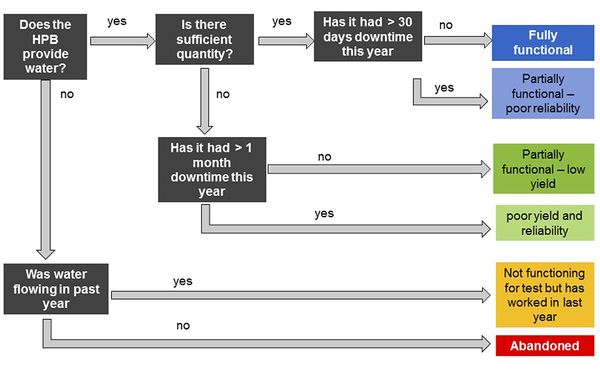OR/17/029 Assessing functionality – different levels of performance - Uganda
| Owor M, MacDonald A M, Bonsor H C, Okullo J, Katusiime F, Alupo G, Berochan G, Tumusiime C, Lapworth D, Whaley L, Lark R M. 2017. UPGro Hidden Crisis Research Consortium — Survey 1 Country Report–Uganda . British Geological Survey Internal Report, OR/17/029. |
 |
The new Sustainable Development Goals (SDGs) set a much stronger focus on sustainability and performance of water services, and have highly ambitious goals to achieve universal access to safe and reliable water for all by 2030 (UN 2013[1]). Poor functionality of water points threatens to undermine progress, and a lack of knowledge for the reasons behind this makes it difficult to recommend improvements and take corrective action. As a first step it is necessary to be able to reliably monitor current rates of functionality and to have a clear benchmark as to what constitutes a functional water point. Currently, there is no single accepted definition for functionality, although organisations are working towards this as a means of tracking progress towards the SDGs.
Guidelines for assessing functionality
Within Hidden Crisis Project we suggest the following guidelines for assessing functionality[2]:
- Functionality should be measured against an explicitly stated standard and population of water points
- It should be measured separately from the users experience of the service it provides.
- The assessments should be tiered, allowing for further information, but always being able to be reduced to a simple measure.
- A distinction can be made between surveying functionality as a snapshot (e.g. for national metrics) and monitoring individual water point performance (including a temporal aspect).
Defining functionality
Survey 1 of the Hidden Crisis project uses the guidelines above to assess functionality in terms of different levels of performance. This starts with a basic ‘yes/no’ definition of whether a water point is working, and moves to a more detailed understanding of the reliability and yield of supply (Figure 1). The final level introduces water quality to the performance assessment. The project is using the following definitions of functionality:
- Basic—is the water point working on day of survey(yes/no)?
- Snapshot—does the water point work and provide sufficient yield (10 L/min) on the day of survey?
- Functionality performance—does the water point provide sufficient yield (10 L/min) on the day of survey, and is it reliable (<30 days downtime in last year)? Or is the water point abandoned (not worked in past year)?
- Functionality including water qualityas 3 above, and also passes WHO inorganic parameters, and thermotolerant coliform (TTC) standards.
Each of these definitions requires different amounts of data to be collected, and a requisite duration of survey. The ‘Basic’ and ‘Snapshot’ assessments reflect the requirements of a widespread national survey assessments, whilst the more performance-focused definitions of 3 and 4 are more relevant to local or regional surveys looking to track the functionality of individual water points or programmes through time.
Standard approaches were used within Survey 1 to collect relevant data to each of these definitions (Appendix 1).
The Survey 1 data provide:
- a more nuanced understanding of the current functionality in each country in terms of performance levels; and
- an insight to the impact of using different definitions of functionality.
